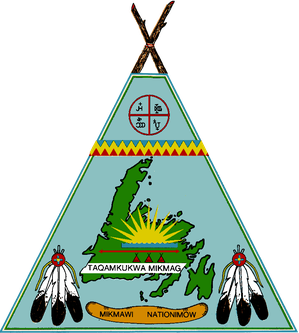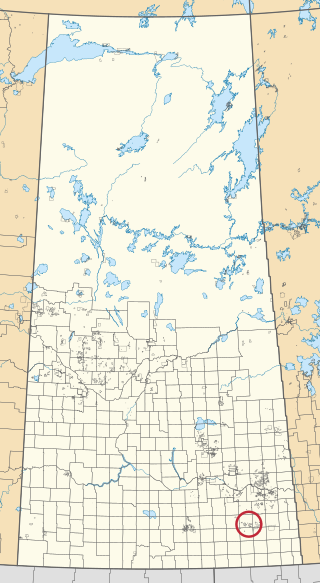Related Research Articles

The Cree are a North American Indigenous people. They live primarily in Canada, where they form one of the country's largest First Nations.

The Chipewyan are a Dene Indigenous Canadian people of the Athabaskan language family, whose ancestors are identified with the Taltheilei Shale archaeological tradition. They are part of the Northern Athabascan group of peoples, and come from what is now Western Canada.

Miawpukek First Nation is a Mi'kmaq First Nations band government in Conne River, Newfoundland and Labrador, Canada, with a registered population of 836 living on-reserve as of May 2023, with another 2,265 living off-reserve. They control the reserve of Samiajij Miawpukek in Bay d'Espoir on the island of Newfoundland. It was formerly known as Conne River Indian Reserve until the mid-1980s. Samiajij Miawpukek was established as a federal Indian reserve in 1987, the first in Newfoundland and Labrador. In 1991, Miawpukek was one of the poorest communities in Atlantic Canada. Due in part to increased education of its members, it has gone on to become the most well-off First Nation in Atlantic Canada after Membertou.

Boyer River 164 is an Indian reserve of the Beaver First Nation in Alberta, located within Mackenzie County. It is 16 kilometers northwest of Fort Vermilion. In the 2016 Canadian Census, it recorded a population of 218 living in 63 of its 67 total private dwellings.

Bushe River 207 is an Indian reserve of the Dene Tha' First Nation in Alberta, located within Mackenzie County. To the west, it is adjacent to the town of High Level. In the 2016 Canadian Census, it recorded a population of 503 living in 134 of its 142 total private dwellings.

Drift Pile River 150 is an Indian reserve of the Driftpile Cree Nation in Alberta, located within Big Lakes County. It is 6 kilometers southeast of Lesser Slave Lake. In the 2016 Canadian Census, it recorded a population of 828 living in 258 of its 277 total private dwellings.

The Buffalo River Dene Nation is a Dene First Nations band government in Saskatchewan, Canada. The band's main community, Dillon, is located on the western shore of Peter Pond Lake at the mouth of the Dillon River, and is accessed by Highway 925 from Highway 155.

The Pessamit Innu Band, which the official name is bande des Innus de Pessamit, is an Indian band of the Innu First Nations in Quebec, Canada. Its members primarily live on the Indian reserve of Pessamit in the Côte-Nord, the north shore of Saint Lawrence River, which is also the seat of the band. In 2017 it has a registered population of 3,953 members. It is governened by a band council called Conseil des Innus de Pessamit and it is affiliated with the Mamuitun Tribal Council. The band was previously known as Bersimis and Betsiamites.
Innu Takuaikan Uashat Mak Mani-Utenam is an Innu First Nations band government in Quebec, Canada. It is based in Sept-Îles in the Côte-Nord region on the North shore of the Saint Lawrence River. It owns two reserves: Maliotenam 27A and Uashat 27 located at both ends of Sept-Îles. It is governed by a band council and is a member of the Mamuitun Tribal Council.

Buffalo River Dene Nation 193 is an Indian reserve of the Buffalo River Dene Nation in Saskatchewan. It is 84 kilometres northwest of Île-à-la-Crosse. In the 2016 Canadian Census, it recorded a population of 783 living in 233 of its 260 total private dwellings. In the same year, its Community Well-Being index was calculated at 54 of 100, compared to 58.4 for the average First Nations community and 77.5 for the average non-Indigenous community.

Clearwater River Dene Band 222 is an Indian reserve of the Clearwater River Dene Nation in Saskatchewan. It is 11 kilometers southwest of La Loche. In the 2016 Canadian Census, it recorded a population of 822 living in 188 of its 218 total private dwellings. In the same year, its Community Well-Being index was calculated at 49 of 100, compared to 58.4 for the average First Nations community and 77.5 for the average non-Indigenous community.

Ocean Man 69 is an Indian reserve of the Ocean Man First Nation in Saskatchewan. It is 20 kilometres northeast of Stoughton. In the 2016 Canadian Census, it recorded a population of 185 living in 56 of its 61 total private dwellings. In the same year, its Community Well-Being index was calculated at 48 of 100, compared to 58.4 for the average First Nations community and 77.5 for the average non-Indigenous community.

Ocean Man 69A is an Indian reserve of the Ocean Man First Nation in Saskatchewan. In the 2016 Canadian Census, it recorded a population of 0 living in 0 of its 0 total private dwellings.

Ocean Man 69C is an Indian reserve of the Ocean Man First Nation in Saskatchewan. In the 2016 Canadian Census, it recorded a population of 0 living in 0 of its 0 total private dwellings.

Ocean Man 69D is an Indian reserve of the Ocean Man First Nation in Saskatchewan. In the 2016 Canadian Census, it recorded a population of 5 living in 2 of its 2 total private dwellings.

Ocean Man 69E is an Indian reserve of the Ocean Man First Nation in Saskatchewan. In the 2016 Canadian Census, it recorded a population of zero with no private dwellings.

Ocean Man 69F is an Indian reserve of the Ocean Man First Nation in Saskatchewan. In the 2016 Canadian Census, it recorded a population of 0 living in 0 of its 0 total private dwellings.

Ocean Man 69G is an Indian reserve of the Ocean Man First Nation in Saskatchewan. In the 2016 Canadian Census, it recorded a population of 0 living in 0 of its 0 total private dwellings.

Ocean Man 69H is an Indian reserve of the Ocean Man First Nation in Saskatchewan. In the 2016 Canadian Census, it recorded a population of 5 living in 3 of its 3 total private dwellings.

Ocean Man 69I is an Indian reserve of the Ocean Man First Nation in Saskatchewan. In the 2016 Canadian Census, it recorded a population of 5 living in 1 of its 1 total private dwellings.
References
- ↑ "Qualicum Governance". Crown–Indigenous Relations and Northern Affairs Canada . Government of Canada. 2016. Retrieved November 16, 2016.
- ↑ "Qualicum". Crown–Indigenous Relations and Northern Affairs Canada . Government of Canada. 2016. Retrieved November 16, 2016.
- ↑ "Census Profile, 2016 Census". Statistics Canada. 2017-04-14. Retrieved 2017-05-16.